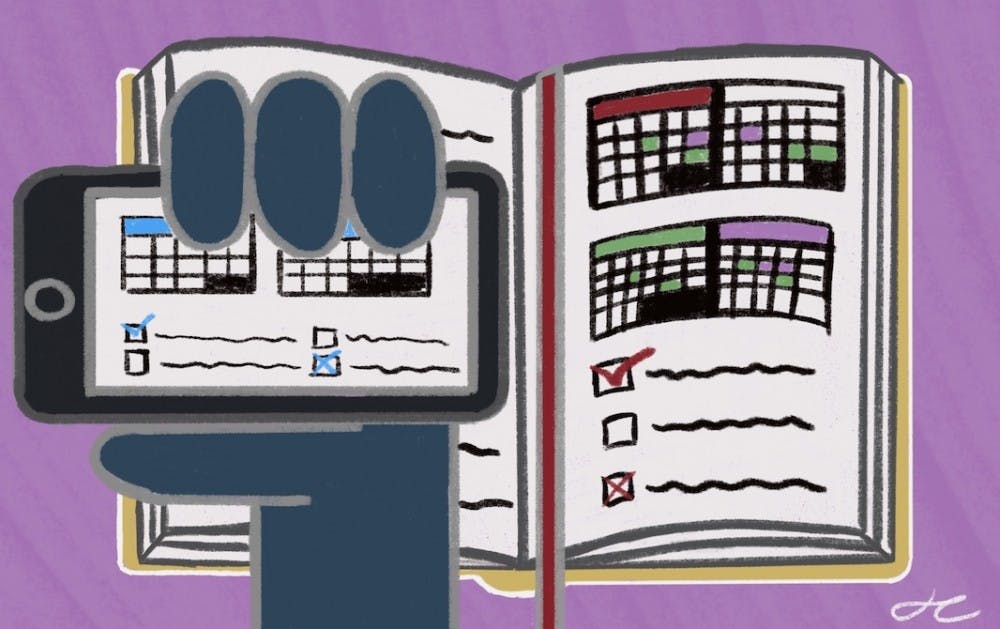Between school work, extracurriculars, jobs and an otherwise busy life, many students rely on some form of planner which, lately, is often digital.
However, some students may find it more useful to shift to a system they have complete control over: the bullet journal.
Bullet journals start out as blank-paged notebooks, leaving plenty of space for students to write down their plans and ideas in a fashion that is as organized or disorganized as they wish.
In an age where an increasing number of activities are performed digitally, it seems as if the physical act of writing is beginning to grow obsolete — a movement that can be partially undone by bullet journaling.
Christa Lynch, a psychology lecturer who teaches classes on memory and cognition, said that there is a shift in the way students are taught to use technology.
“I think the argument is that this generation is going to grow without having to write anything,” Lynch said. “I argue that yeah, maybe in school, but what if you’re addressing a letter or what if you’re just jotting down a list for what to buy at the grocery store? Those are some things that are really a part of our existence and of memory. The ability to do that is going to be a lost art.”
Skylar Richter, a freshman studying communications, said she uses her bullet journal to help her manage daily tasks.
“It helps me stay organized and release stress,” Richter said. “It’s kind of a way to organize my thoughts in general. I do it day by day with things I have to do — I know a lot of people do it in different ways, like by month or by week — I do it day by day because that works for me.”
By nature, bullet journals are intended to be the most personalized method of organization possible, providing students with not only an organizational outlet, but also a creative one.
Students can decorate the pages of their bullet journal or experiment with different styles of handwriting — the aesthetic aspect of organization inspires both conversation and social media posts.
"Generally speaking, you’re able to cater to yourself, which is unlike even the planners that you buy where the structure’s set up for you,” Lynch said. “When you have that blank space to just do it however it makes sense to you and however is most meaningful for you, by the time you’re done putting in all your appointments, you’ve already probably got most of it in your head.”
Although some students may find physically writing down notes in a fast-paced lecture challenging, they should aim still to incorporate writing in at least some aspect of their daily routine due to their biological benefits, such as an increased likelihood of remembering what they write down.
“When you write, there’s actually a certain area of the brain that lights up, and that’s the Broca’s area — the area for language,” Lynch said. “That’s part of memory, too. When you’re writing, it’s not just the sensation, it’s the part of the brain that connects all your ideas to verbal abilities. It just makes sense that we start with those connections. It’s somewhat mindless when we are just typing.”
The flexibility of bullet journaling is not found to the same extent in other forms of planning, which may mean some students might find themselves less efficient using a system that is too structured for their needs.
“It’s like working with another person, you can’t really rely on it,” Lynch said. “They do their own thing which may or may not make sense to you, but unfortunately it’s like this person ‘rules your life.’ So you have to adapt to that person and it’s really not natural. Our natural tendency is to do what makes sense to us.”
Students who find that technology do not meet their expectations might consider optimizing their organization by investing in a physical planner once again and writing down their to-do lists in a way that makes sense to them.
“My journal is kind of like a planner for me, but I hate the way (typical) planners are set up,” Richter said. “I can do things the way I want to.”
Reach the columnist at kalbal@asu.edu or follow @KarishmaAlbal on Twitter.
Editor’s note: The opinions presented in this column are the author’s and do not imply any endorsement from The State Press or its editors.
Want to join the conversation? Send an email to opiniondesk.statepress@gmail.com. Keep letters under 500 words and be sure to include your university affiliation. Anonymity will not be granted.
Like The State Press on Facebook and follow @statepress on Twitter.




